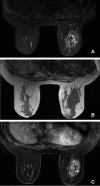A Case Report: Pseudoangiomatous Stromal Hyperplasia Tumor Presenting as a Palpable Mass
- PMID: 26835457
- PMCID: PMC4717308
- DOI: 10.3389/fsurg.2015.00073
A Case Report: Pseudoangiomatous Stromal Hyperplasia Tumor Presenting as a Palpable Mass
Abstract
We report a case of woman with a palpable lump on her left breast. On mammography, a huge mass located between the inner and the outer inferior breast quadrants of the left breast was found. The ultrasound examination realized later revealed a heterogeneous mass with smooth and lobulated borders. An MRI was also performed, showing an oval mass with heterogeneous areas of enhancement. Finally, a core biopsy under sonographic guidance revealed a pseudoangiomatous stromal hyperplasia of the breast.
Keywords: MRI; breast tumor; mammography; phyllode tumor; pseudoangiomatous stromal hyperplasia.
Figures




References
-
- Anderson C, Ricci A, Jr, Pedersen CA, Cartun RW. Immunocytochemical analysis of estrogen and progesterone receptors in benign stromal lesions of the breast. Evidence for hormonal etiology in pseudoangiomatous hyperplasia of mammary stroma. Am J Surg Pathol (1991) 15(2):145–9.10.1097/00000478-199102000-00007 - DOI - PubMed
-
- Cohen MA, Morris EA, Rosen PP, Dershaw DD, Liberman L, Abramson AF. Pseudoangiomatous stromal hyperplasia: mammographic, sonographic, and clinical patterns. Radiology (1996) 198(1):117–20. - PubMed
Publication types
LinkOut - more resources
Full Text Sources
Other Literature Sources

